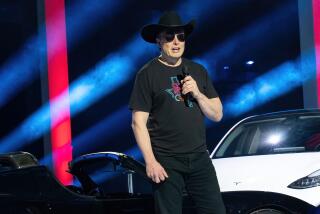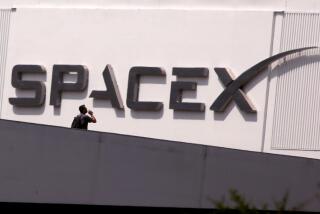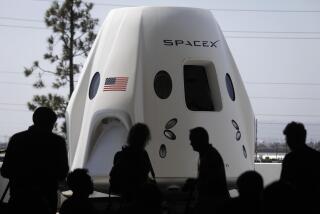GM’s Decision on Its Saturn Plant Site Will Come as Relief to Many
DETROIT — Sometime very soon, perhaps this week, General Motors will announce where it will build its Saturn plant, and the months-long frenzy surrounding the selection of a site for the most sought-after industrial development of the 1980s will finally end.
When that happens, governors desperately seeking Saturn will no longer appear on the Phil Donahue show to explain why their states are just right for the new, $5-billion GM subsidiary. Billboards on Detroit’s freeways paid for by cities and states such as Chicago, Iowa, Missouri and Youngstown, Ohio, in an effort to woo the economic plum will come down. And eager Detroit-area newspaper reporters will no longer search garbage cans in back of GM office buildings for hints about where Saturn will land.
Ever since GM announced in January that its new Saturn subsidiary will build a plant somewhere in the United States in a last-ditch effort to compete profitably with the Japanese in producing small cars, the battle for Saturn has been noisy and fierce.
Politicians have been after Saturn because GM has been touting it as the most important project in the modern history of the auto industry. The company has even taken to describing Saturn as the private-sector equivalent of the Apollo moon-landing project of the 1960s--a huge, crash project with an ambitious goal--to outdo the Japanese at their own small-car game. (GM even named Saturn after the rocket that took American astronauts to the moon.)
The auto maker set up an independent subsidiary with assets of $5 billion in an effort to build a cost-competitive subcompact in a high-tech assembly complex expected to employ 6,000 workers by the end of the decade, and almost every state, including California, has hungrily sought the venture.
In addition, Saturn is expected to create another 14,000 “indirect” jobs, including many at outside parts suppliers and service companies located near the assembly complex.
27 Governors Made Pitch
Governors of 27 states have shuttled in and out of Detroit since January to meet with GM Chairman Roger B. Smith, and 35 to 40 states have officially submitted bids, a GM spokesman says. GM initially planned to look at just 20 locations around the country and make its site decision by the end of April, but it was forced to delay the announcement after being stunned by an enormous outpouring of interest in Saturn.
Company spokesman Stan Hall says state and local government leaders have submitted data on about 1,000 potential sites for Saturn, and GM executives have filled 20 large office cabinets with data submitted by the various states and individual communities.
Last week, GM officials said they have finally selected a site but won’t announce it until the company hammers out a labor agreement with the United Auto Workers covering Saturn’s workers. Sources at the UAW, meanwhile, say that they hope to put the finishing touches on a contract within the next few days and that both the new contract and the Saturn plant’s site could be announced simultaneously later this week.
UAW officials say last-minute wrangling inside the union over controversial contract language that would fundamentally alter the union’s relationship with management has delayed an announcement of a Saturn labor accord, which had been expected last week.
Despite the press scrutiny and heavy political lobbying, however, GM has been remarkably successful in keeping its secret. The current betting in Detroit is that the Saturn plant will be built in one of three communities--Schoolcraft Township, Mich., about 20 miles south of Kalamazoo; Shelbyville, Ky., about 30 miles east of Louisville, or Spring Hill, Tenn., about 30 miles south of Nashville. (California officials said last week that they believe that the state is out of the running.)
Although GM has labeled as “highly speculative” press reports listing those locations as finalists, industry observers close to GM say they have been told that sites in Michigan, Kentucky and Tennessee are the only ones that have recently been under consideration. And local economic development officials in Kalamazoo said Monday that they were told late last week by state officials that their area, along with one or two others, is still in the running.
In fact, Kalamazoo (population: 80,000) is so sure that it is a finalist that local officials are already double-checking the hotel availability for an expected horde of reporters that will descend on their southwestern Michigan community after the announcement.
“It’s hard not to be informed about what’s going on with Saturn around here,” says Lucinda Huis, assistant director of the Kalamazoo County Economic Expansion Corporation. “It is in the headlines of all the papers and on every TV all the time. I think the press here is running out of stories. The rumor mill is running dry.”
Meanwhile, out-of-town attorneys who won’t say who they are working for have been crawling all over the courthouse in rural Maury County, near the Tennessee site, looking over local land claims, according to Spring Hill Mayor George Jones. He adds that unidentified surveyors have been out in the last week to inspect a big chunk of land on the edge of the town (population: 1,100). “It’s kind of scary, but it looks like it’s going to come,” Jones says.
In the midst of all the speculation, one thing seems clear: Most observers believe that the Saturn site selection has dragged on too long and that GM may encounter public resentment for allowing the hopes of so many communities to be raised falsely.
Consumer activist Ralph Nader has blasted GM for holding local elected leaders around the country “hostage” during the long process. In a letter to GM’s Smith that Nader made public, he even called Sen. Donald Riegle (D.-Mich.) a “wimp” for allegedly pledging loyalty to GM on other issues in exchange for considering Michigan as a site for Saturn. Riegle dismissed the charge.
“This (public competition for Saturn) has been sort of a mistake for GM,” observes David Cole, director of the Center for the Study of Automotive Transportation at the University of Michigan.
“This thing has been hyped up beyond what was reasonable, and the hysteria may be an impediment,” notes Martin Anderson, a widely respected auto industry consultant. “The expectations are far too high.”
Local officials in the towns rumored to be finalists seem to agree. “There is a lot of talk around town, but I’d just like to have the announcement made so we can go on with our daily business,” complains Neil Hackworth, mayor of Shelbyville (population: 5,500).
But GM officials respond that they didn’t instigate the competition for Saturn; they say the politicians came after them after Smith simply announced plans to build a plant. “We didn’t invite the governors in here,” GM spokesman Clifford Merriott insists. “They invited themselves.”
He notes that after the first visit to GM by a governor--Illinois Republican James R. Thompson within days of the Saturn announcement last January--GM officials couldn’t refuse to see others as well, and so the public competition among the states heated up.
Still, officials in some states that already appear to be out of the running don’t believe theirs was wasted effort. By focusing so much attention on industrial development, some states that bid for Saturn believe that they are now in a better position to attract other projects.
Despite offering GM $1.2 billion in public and private incentives, (including passage of special legislation that would have allowed Saturn to avoid paying any property, corporate income or sales taxes for 30 years if it located in the state) Minnesota appears to be out of the race.
“But even if we don’t succeed in getting Saturn, it will still have been a good exercise for the state because it has shown us that we need to mount a joint effort by business and government to attract new industry and jobs,” says Jim Gelbmann, a top aide in the state Commission on Economic Development.
In Missouri, meanwhile, state economic development officials are putting together a promotional campaign to tell business leaders that Missouri will offer Saturn-like incentives to any big new industry entering the state, according to a spokesman for Gov. John Ashcroft.
Such side effects could provide the most important long-term benefit of the Saturn sweepstakes, Cole notes. “I’ve been somewhat shocked with the public bidding for Saturn,” Cole says. “But in the end, probably more good things than bad things will come out of it. Local leaders are beginning to understand that businesses don’t just come to their states in order to bless them with more tax revenues. There is an international competition for industry out there, and people need to start thinking about that.”
RACE FOR SATURN: THE FINAL CHAPTER
The location of General Motors new Saturn automobile plant, a $5-billion subsidiary and the mostsought-after industrial development of the 1980s, is expected to be announced this week. GM has been successfully tight-lipped about which American community will “win,” but the current betting in Detroit is that the Saturn plant will be built in one of three communities: Schoolcraft Township, Mich., just south of Kalamazoo; Shelbyville, Ky., east of Louisville; or Spring Hill, Tenn., in Maury County, south of Nashville. What the Winner Will Get Expenditure of $3.5 billion by GM in the local economy to build the chief plant of its new subsidiary.
A highly automated manufacturing complex that will include stamping, parts-making and auto assembly operations.
Up to 6,000 new jobs on two shifts, with a local payroll of $200 million annually.
Another 14,000 jobs at supplier companies, many of which will be located in the same area.






